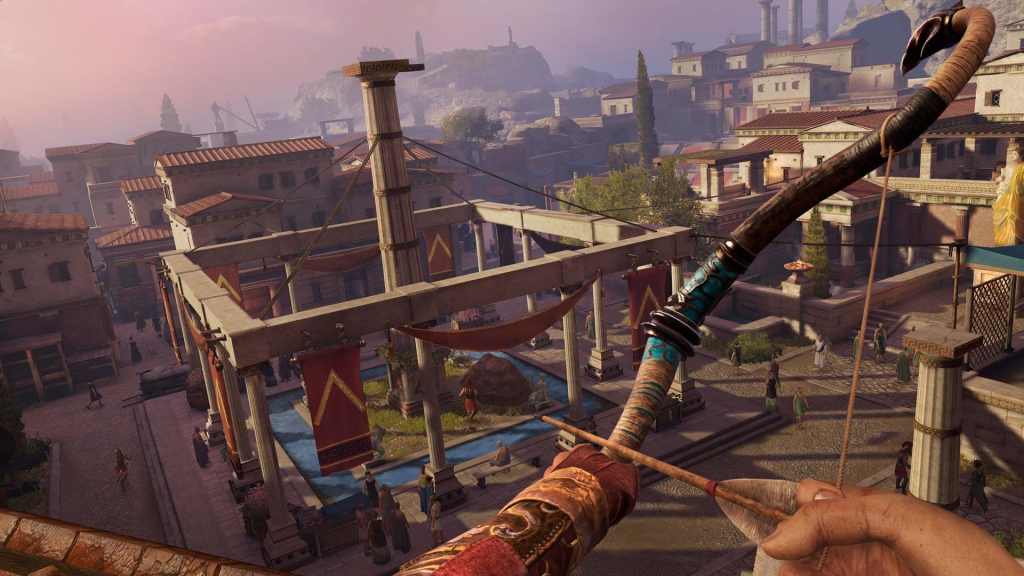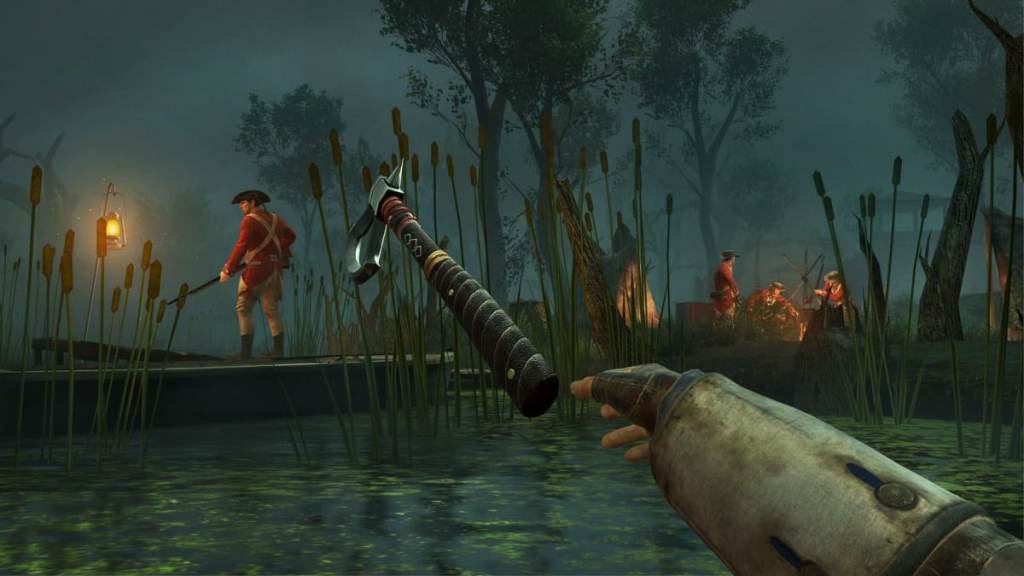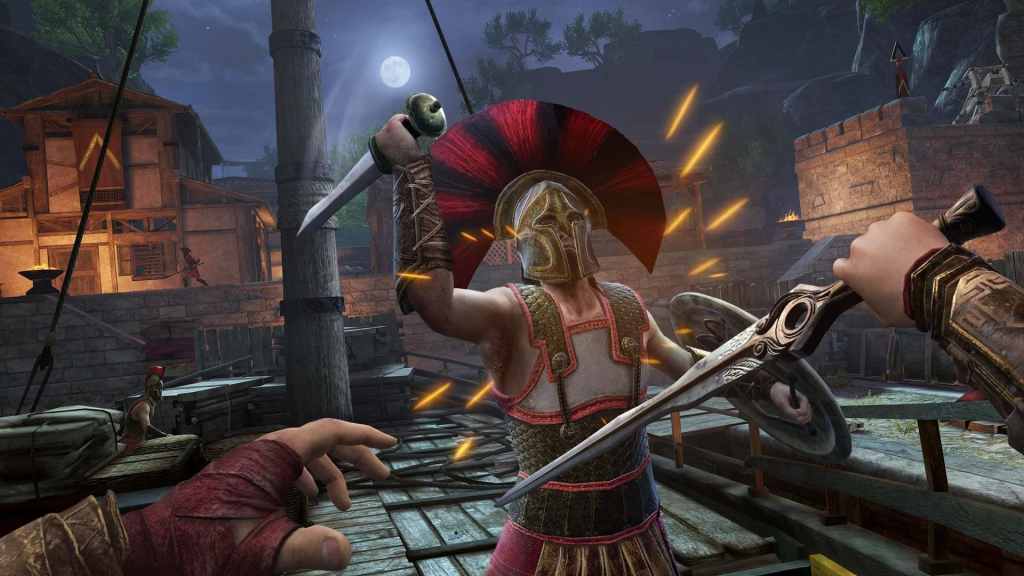Taking the Meta Quest 3 headset off after playing Assassin’s Creed Nexus VR is a dizzying experience. It’s not so much vertigo, but rather you feel a strange sense of detachment, and pulling away from a world that feels impressively real. VR games have, in the past, struggled in building their immersive worlds, and really involving players in a world that feels tangible and gripping. Nexus does not represent perfection in this art, but it makes great strides forward for VR adventuring, with a crafted world, narrative, and characters that are confident, well-designed, and very compelling.
In taking off your VR headset, after hours of running along buildings, jumping up walls, and committing stealth-infused acts of espionage (and occasionally, murder), extricating yourself is difficult, for all the right reasons.
Parkour through history
Nexus kicks off in rapid fashion, as you’re introduced to a layered metanarrative that weaves between chapters of Assassin’s Creed history, both familiar and new. You are a hacker working undercover at Abstergo, guided by series mainstays, Shaun Hastings and Rebecca Crane.
Both want to discover the secrets of Abstergo – largely, why they’re searching for the ancient computer known as the Antikythera mechanism. Under the leadership of Dominika Wilk, played with much gravitas by sci-fi legend Morena Baccarin, your job is to retrieve the fragments of this machine, by romping through digital recreations of history – Renaissance Italy, Ancient Greece, and 18th Century America.

In each chapter, you’re given all-important freedom to roam, complete challenges, discover collectibles, and run through a gauntlet of puzzles, stealth sequences, high-speed traversal and combat encounters. The mix of activity is what makes Nexus so captivating – and so well-rounded for a VR game. In each chapter, you’ll typically be tasked with one or two overarching missions (find someone, kill someone, infiltrate an area, steal an item) with your journey then broken up into bite-sized portions of puzzles, combat, and mini-quests that allow you to explore freely – and also learn more about history, via collectible data shards.
Read: Assassin’s Creed Mirage Review – Turning Back Time
While segmented into chapters based on characters and individual biomes, each world in Nexus is fairly large and open, allowing you to spend time really embodying each of the game’s main characters – returning assassins Ezio, Connor, and Kassandra – and bask in crisp virtual surrounds that feel incredibly novel. You can take your time here, with plenty of challenges to surmount, and around 12-15 hours of total gameplay, depending on your speed and prowess.
Each locale you’ll visit is based on past Assassin’s Creed games, but the VR format allows a fresh, new perspective. Entering Monteriggioni in Nexus, you can instantly spot locations from AC2, and feel a strange sense of deja vu – particularly wandering outside the city gates. This area is particularly iconic in the franchise, but with Nexus, you feel a renewed sense of awe at its scale and grandeur – in a tangible way you can only really grasp within a VR environment.
Playing the game with the newly-released Meta Quest 3, which was provided to GamesHub by Ubisoft and Meta for the purposes of reviewing Nexus, also aided that sense of wonder. This headset is a vast leap above its predecessor, with a stronger processor, easier wearability, and more accurate controllers boosting the scope of Nexus greatly. It’s an incredibly good-looking game on the Meta Quest 3, with crisp text, clean UI and menus, sharp graphics, and great focus.
Ancient Greece, the realm of Kassandra, looks particularly colourful and eye-catching in Nexus, with the Meta Quest 3 allowing detailed, decorated concrete structures to tower overhead, and blue skies to shine down through fluffy white clouds. This Ancient Greece is a paradise, and even while on a mission to kill, its beauty shines through in every facet. Likewise, Italy is very fetching, with regal buildings giving way to vast open skies, and rooftops giving a gorgeous glimpse out across iconic cities, including the watery town of Venice.

Connor’s chapters, while equally riveting in narrative and scope, benefit slightly less from that sense of awe, if only because colonial America is a land of concrete and paved stone, with far less natural beauty.
Winding roads, twisting knives
Beyond the backdrops, Assassin’s Creed Nexus VR also shines in its approach to storytelling. A common stumbling block of VR, in general, is a heavy focus on gimmickry without consideration for the magic that a strong VR narrative can deliver. Nexus manages a great balance of its many aspects, infusing its wide-eyed exploration with curious narrative touches that infuse every mission with a sense of purpose, and encouragement to delve further.
Its three unique plot threads, which see Ezio, Kassandra, and Connor completing missions as a means for the hacker player character to uncover the location of the Antikythera mechanism, are tied together well, despite being excuses to revisit Assassin’s Creed history, and invoke a nostalgia in returning players.
It’s clear that Nexus aims to allow players the power fantasy of embodying an assassin through various eras in history – but the writers of Nexus have added in other layers to tie this particular game into Assassin’s Creed canon, to evoke the plot threads of the original games, and to provide a sense of cohesion between its disparate time periods.
This is essentially a “best of” collection Assassin’s Creed adventures, with the narrative wound deftly around each assassin – in ways we haven’t quite seen before. There’s plenty of potential in Ubisoft crossing over its most popular characters and revisiting their triumphs, and in Nexus, the experiment pays off well, with each assassin getting ample time in the spotlight, thanks to unique character mechanics, missions, and worlds.

Kassandra, for example, has one giant hidden blade, where Connor and Ezio have two smaller ones. Ezio also gains access to a wrist-mounted crossbow in his journey, where the other assassins discover divergent weaponry, and other combat tactics. While only a small twist on your path forward, it means that each chapter feels relatively unique, and that the action clips along at a rapid pace, revealing new mechanics with every completed goal.
As you travel, you’ll work towards mastering this ever-growing skillset, with the game’s combat being a fascinating mix of stealth and skirmishes. Stealth is usually the better option as you travel, as it allows for a slower pace, and more creativity. You can take the high road, climbing up buildings using any means necessary (nearly everything is climbable here), and then deploy your hidden blade for a ground attack, grab a bow and arrow for rapid-fire dispatches, or bring out your knives.
Any of these options are viable, thanks to the game’s sense of freedom – and they all feel fantastic, with neat mechanics and haptics providing that needed believability for loading bows and aiming with knives. While the game does feel slightly too generous sometimes, with each wild shot hitting its mark with precision, this doesn’t take away from the sense of choice and immersion.
Where combat is slightly less effective is in the game’s skirmishes, where stealth fails and guards begin to attack in one-on-one or multiple-on-one battles. Here, the action slows down considerably, as you enter a dance-like state where you must dodge or block very slow attacks from enemies.

The game’s AI is lacklustre and not particularly clever, so combat never feels very challenging – and in fact, feels occasionally janky. More often than not, you can win battles simply by throwing your controller around or swinging it in the air until your opponent fails to block your move.
Entering the uncanny valley
Realistically, this combat jank is more a result of the experimental nature of VR itself – a technology which has yet to reach its pinnacle despite rapid and vast improvements in the last two decades.
By nature, Assassin’s Creed Nexus VR is slightly unnatural-feeling, in small doses that still make a massive impact while you’re playing. In creating a virtual world, details must be perfect, or there’s a natural revulsion from players. Any disconnect between a player’s virtual body and their real world, or their sense of perception, will naturally lead to the uncanny valley.
Nexus does a lot to paper over this. Assassins have full bodies that can be viewed when looking down, so there’s no strange disconnect between floating hands or weapons. There’s even a nose toggle if you’d like to see a virtual nose, as you would in real life. Hand movements are also very effectively tracked, and traversal in the world feels smooth and easy to track.
But there are moments when the world will glitch and change, in a way that immediately takes you out of the action. Frame rate slow down happens on frequent occasions, particularly when you’re running through a world, and this causes confusing visual judders. There are also moments when the hand grip action falters, and you can fall off walls suddenly. Get too close to an object, and your world will go completely dark.

The disconnect is also very apparent when you’re talking to NPCs, as the game’s graphics are closer to the PlayStation 3 / Xbox 360 era when it comes to character models, with glowing eyes, too-white teeth, and uncannily smooth skin making characters seem alien and off-putting. VR games will get better in this regard, but in Nexus, it still feels jarring.
The nexus of all things
Regardless of these teething issues, which are overall forgivable and still quite typical of VR adventures, Assassin’s Creed Nexus VR proves itself to be a worthy virtual reality adventure, filled with novel ideas that expand the world of Assassin’s Creed, while underlining the potential of VR as a storytelling medium.
In balancing each of its aspects, Ubisoft makes a solid case for VR games to be far more ambitious in scope, going forward. From wandering through the Vault of Odysseus, to letting off fireworks in the heart of Venice, to solving interplanetary Myst-like environment puzzles and flinging yourself across deadly dungeon caverns, there’s plenty of awe-inspiring novelty in this journey.
If ever there was a compelling reason to invest in the new generation of VR hardware, Assassin’s Creed Nexus VR is it.
4 Stars: ★★★★
Assassin’s Creed Nexus VR
Platforms: Meta Quest 3, Meta Quest 2, Meta Quest Pro
Developer: Ubisoft
Publisher: Ubisoft
Release Date: 16 November 2023
Assassin’s Creed Nexus VR and a Meta Quest 3 was provided and played for the purposes of this review. GamesHub reviews are rated on a 5-point scale.





